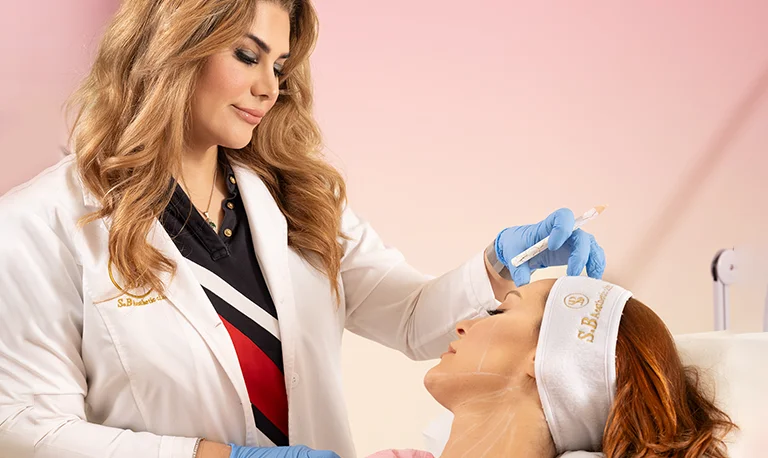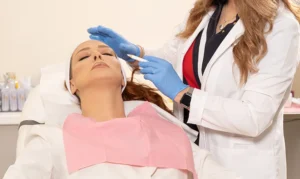Thanks to non-surgical facelift solutions, people can refresh their appearance without invasive surgical treatments. These procedures can enhance facial features, improve the skin’s texture and lessen the appearance of ageing. Following are a few well-liked non-surgical facelift choices:
Dermal Fillers:
Hyaluronic acid-based treatments (like Juvederm and Restylane), used as dermal fillers to smooth out wrinkles and fine lines, are frequently used to add volume to the face. They can be utilised to define the jawline, lift sagging cheeks, and increase lip fullness. Results might range from a few months to a few years and are frequently immediate.
Botox And Dysport:
Botulinum toxin injections, such as Dysport and Botox, are used to relax the muscles that cause dynamic wrinkles, or wrinkles brought on by facial emotions. They work well to address frown lines and forehead lines. Usually, results linger for several months. Botulinum toxin injections are a common option for people seeking short-term treatment for dynamic wrinkles. Dysport and Botox significantly reduce the appearance of cosmetic frown lines and forehead wrinkles by targeting particular facial muscles. These results are usually long-lasting, giving people a refreshed and youthful appearance for several months.
Thread Lifts:
During a thread lift procedure, small threads are inserted beneath the skin to raise and tighten drooping tissue. They enhance the texture and flexibility of the skin by stimulating collagen formation. Thread lifts can be applied to the neck, jawline, and midface for a modest lifting effect.
Radiofrequency, Or RF, Treatments:
RF treatments heat the skin and promote collagen formation using energy. Sagging skin can be tightened, and facial features can be improved with tools like Thermage and Profound. By sending radiofrequency radiation down into the skin, these devices encourage the growth of new collagen fibres. Aids in restoring the look of youth by tightening saggy skin. Non-invasive and requiring little to no downtime, RF treatments are popular for people seeking non-surgical rejuvenation.
Chemical Peels:
A chemical solution is applied to the skin to exfoliate the top layer, revealing younger-looking, smoother skin. Variable peels offer different levels of exfoliation and recovery time. Substantial. Whereas mild peels may only result in a little redness and require little recovery time, deep peels may result in more substantial peeling and need more time to heal.
Microcurrent Treatment Facials:
Microcurrent facials stimulate the facial muscles with low-level electrical currents to tighten and tone the skin. They’re frequently called “natural facelifts.” These electrical currents stimulate the creation of collagen and enhance blood circulation by imitating the body’s natural bioelectrical signals. Microcurrent facials give the outermost layer of skin a more young and revitalised appearance.
PRP Treatment:
A tiny amount of the patient’s blood must be drawn, processed to concentrate the platelets, and injected under the skin. PRP can enhance collagen production, lessen wrinkles, and improve skin texture. PRP therapy uses the healing abilities of platelets to promote tissue regeneration in a minimally invasive manner. PRP’s concentrated platelets include growth factors that encourage the synthesis of freshly formed collagen, giving the skin a firmer and more youthful appearance. By stimulating the hair follicles, PRP may also treat hair loss and encourage hair growth.
Topical Skincare:
These substances, antioxidants, hyaluronic acid (HA), and other active compounds in high-quality skincare products can help preserve the effects of other treatments while enhancing skin health. Vitamins C and E are examples of antioxidants that operate by scavenging dangerous free radicals that can potentially injure the skin and hasten ageing. On the other hand, hyaluronic acid is a potent moisturiser that can moisturise the skin and increase its suppleness. Combined with other active ingredients, these can offer a thorough skincare routine that nourishes and protects the skin for a healthy, youthful appearance.
Speaking with a dermatologist or healthcare professional who is knowledgeable and skilled when thinking about non-surgical facelift solutions is essential. They can evaluate your particular requirements, discuss your objectives, and suggest a treatment strategy suited to your needs. To assist you in choosing the best non-surgical facelift option, they can also explain potential risks, benefits, and projected outcomes.



